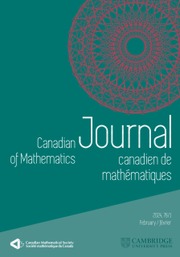Article contents
Limits of Lattices in a Compactly Generated Group
Published online by Cambridge University Press: 20 November 2018
Extract
Let G be a locally compact and (σ-compact topological group and let H be a discrete subgroup of G. We shall use G/H to denote the space of right cosets Hx of H with the usual topology (cf. (8, pp. 26-28)). Let μ be the left Haar measure in G. μ induces a measure in the space G/H3; this measure will, without ambiguity in this paper, also be denoted by μ. If μ(G/H) is finite, the group H is called a lattice. If the space G/H is compact, then H is certainly a lattice and is called a bounded lattice. These terms are an extension of the usage of the Geometry of Numbers, where G is the real n-dimensional vector space Rn . In this case any lattice is generated by n linearly independent vectors, all lattices are bounded, and the whole family of lattices is permuted transitively by the automorphisms of G (which are the non-singular linear transformations).
Information
- Type
- Research Article
- Information
- Copyright
- Copyright © Canadian Mathematical Society 1960
References
- 8
- Cited by

